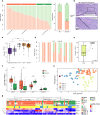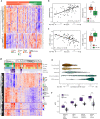Heterogeneity of neuroendocrine transcriptional states in metastatic small cell lung cancers and patient-derived models
- PMID: 35440132
- PMCID: PMC9018864
- DOI: 10.1038/s41467-022-29517-9
Heterogeneity of neuroendocrine transcriptional states in metastatic small cell lung cancers and patient-derived models
Abstract
Molecular subtypes of small cell lung cancer (SCLC) defined by the expression of key transcription regulators have recently been proposed in cell lines and limited number of primary tumors. The clinical and biological implications of neuroendocrine (NE) subtypes in metastatic SCLC, and the extent to which they vary within and between patient tumors and in patient-derived models is not known. We integrate histology, transcriptome, exome, and treatment outcomes of SCLC from a range of metastatic sites, revealing complex intra- and intertumoral heterogeneity of NE differentiation. Transcriptomic analysis confirms previously described subtypes based on ASCL1, NEUROD1, POU2F3, YAP1, and ATOH1 expression, and reveal a clinical subtype with hybrid NE and non-NE phenotypes, marked by chemotherapy-resistance and exceedingly poor outcomes. NE tumors are more likely to have RB1, NOTCH, and chromatin modifier gene mutations, upregulation of DNA damage response genes, and are more likely to respond to replication stress targeted therapies. In contrast, patients preferentially benefited from immunotherapy if their tumors were non-NE. Transcriptional phenotypes strongly skew towards the NE state in patient-derived model systems, an observation that was confirmed in paired patient-matched tumors and xenografts. We provide a framework that unifies transcriptomic and genomic dimensions of metastatic SCLC. The marked differences in transcriptional diversity between patient tumors and model systems are likely to have implications in development of novel therapeutic agents.
© 2022. This is a U.S. Government work and not under copyright protection in the US; foreign copyright protection may apply.
Conflict of interest statement
D.L. in an employee of AstraZeneca. A.T. report research funding to the institution from the following entities: EMD Serono, AstraZeneca, Tarveda Therapeutics, Prolynx Inc, and Immunomedics. The other authors have no competing interest to declare. None of the authors have competing non-financial interests.
Figures







References
-
- Carney DN, et al. Establishment and identification of small cell lung-cancer cell-lines having classic and variant features. Cancer Res. 1985;45:2913–2923. - PubMed
Publication types
MeSH terms
Substances
Grants and funding
LinkOut - more resources
Full Text Sources
Medical
Miscellaneous

